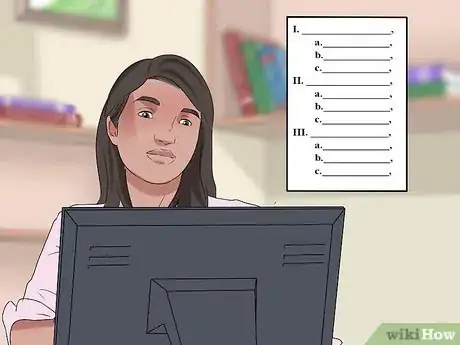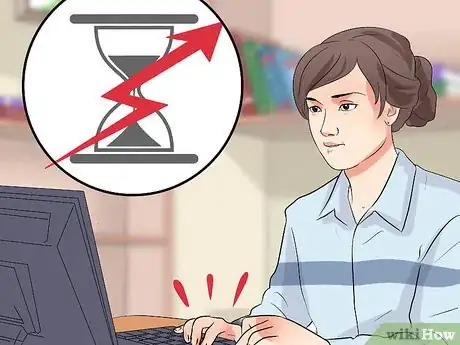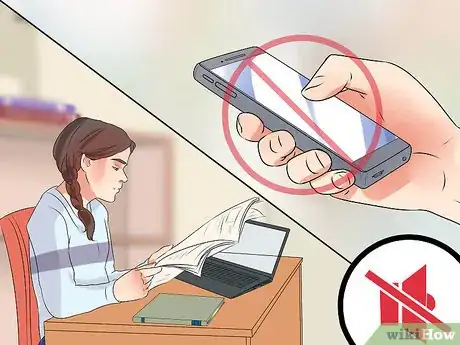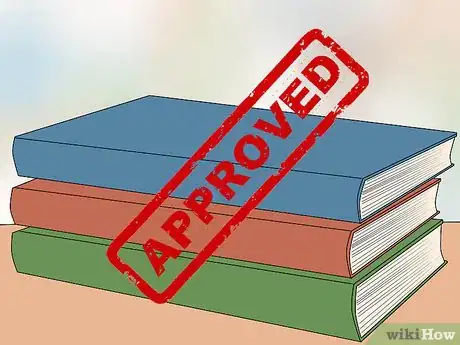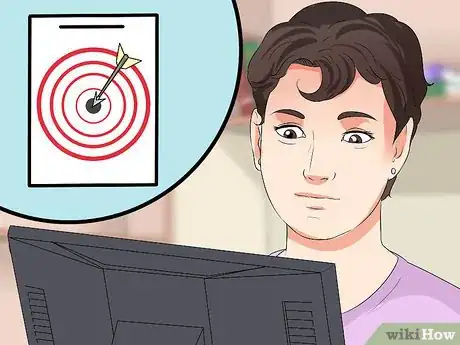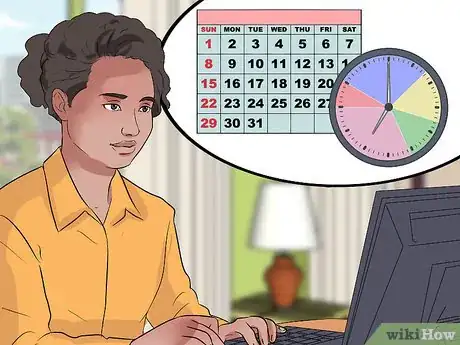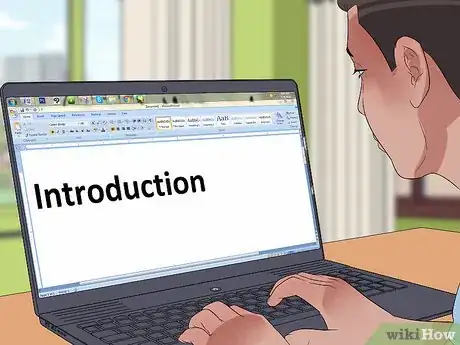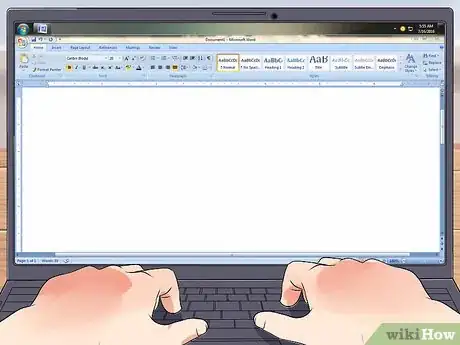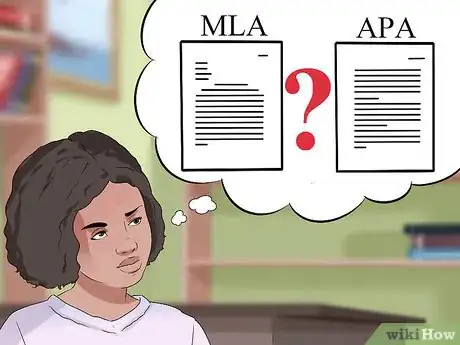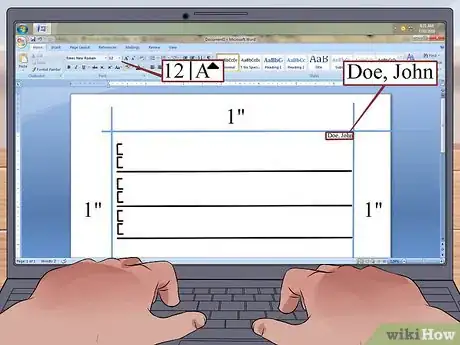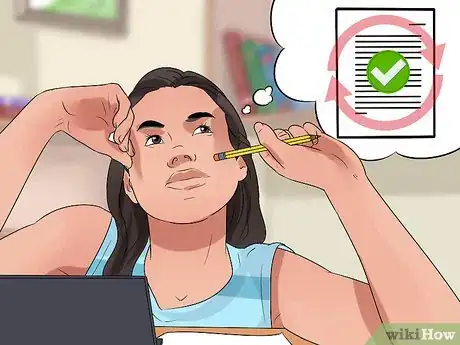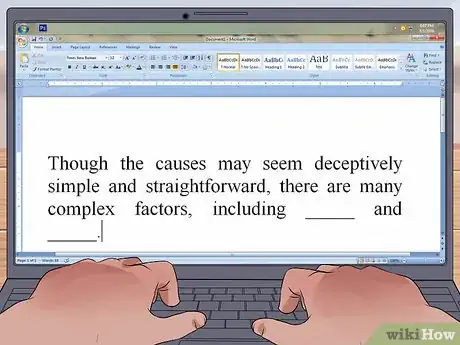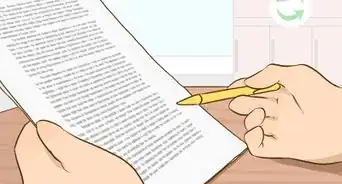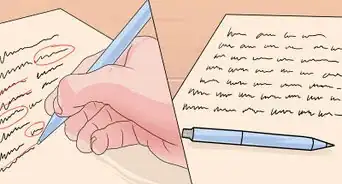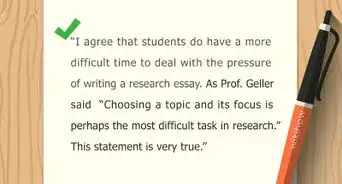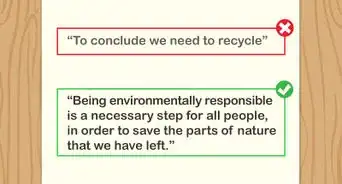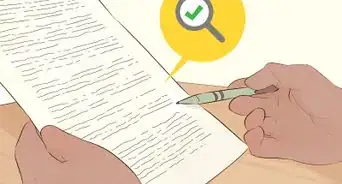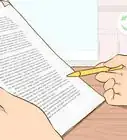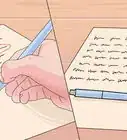This article was co-authored by Christopher Taylor, PhD. Christopher Taylor is an Adjunct Assistant Professor of English at Austin Community College in Texas. He received his PhD in English Literature and Medieval Studies from the University of Texas at Austin in 2014.
There are 20 references cited in this article, which can be found at the bottom of the page.
This article has been viewed 66,290 times.
When it comes to school work, planning and preparation are important. However, sometimes you may be forced to write a paper in a very short span of time. This situation may be caused by a health problem or family emergency, or it could be a simple case of procrastination. Whatever caused you to put off writing your paper, you can still pull off a short assignment in a single day.
Steps
Planning a Paper Under Time Pressure
-
1Choose an appropriate topic. Before you can write a paper, you'll need a topic to work on. If you were assigned a topic by your instructor, then you won't need to worry about coming up with an appropriate subject. If not, you'll need to come up with your own topic to write about.
- If you're having a hard time coming up with a relevant topic, you can try brainstorming. Set a timer for 60 seconds and list as many ideas that come to mind without stopping until the timer goes off.[1]
- Your topic should address a clear, concise research question.[2] For example, once you’ve decided to write about the U.S. Civil War, you’ll need to narrow down the topic. Your research question could be, “How did the Battle of Antietam impact the Civil War?”
- The best research papers make a clearly-articulated argument for or against a thesis derived from your research question. For example, you might make the claim that the Battle of Antietam led to a Union victory in the Civil War. In your paper, explain exactly how the battle led to a Union victory.
-
2Conduct the necessary research. Research is usually a requirement of most school papers, including shorter assignments. However, if your instructor told you that you do not need to do research or incorporate sources, then you won't need to search for or cite texts to support your argument in this paper.[3]
- Depending on your topic, you may need some primary sources, which are generally considered eyewitness accounts that may include interviews, diaries, recordings, or surveys.[4]
- Your instructor will probably accept secondary sources for a two-page paper. These include thoroughly-researched texts about a person, place, or event, such as an academic journal article, encyclopedia entry, or textbook subject.[5]
- You can find both primary and secondary sources by doing research at the library or by searching online.
Advertisement -
3Consider outlining your paper. While outlining take a bit of effort, it leads to clear, organized, and efficient writing. Outlining can simplify the writing process, but not everyone likes to work with an outline. This will largely depend on your own personal writing style. If you do decide to use an outline, though, it's important that you make an outline that will be most helpful for you.[6]
- Draft your thesis statement/argument in your outline.
- Come up with a list of major points that support your argument.
- Next, create a sub-list of ways to support each major point. This sub-list should be derived from your research and should make it easy for you to plug in each point and source when you write your paper.
- Your outline can be more or less detailed, depending on your writing style. For example, instead of breaking down each paragraph of the paper in your outline by idea and citation, you might just list what you will discuss in each paragraph and how it relates to the thesis.
-
4Work as efficiently as possible. Planning out a long paper can take a good deal of time and energy. If you're trying to get your paper done in one day, you probably don't have much of either. If you have the time, you should absolutely work out a thorough and detailed outline. However, if you don't think you'll be able to get the paper done in time, you may need to condense your outline to focus on the basics.
- While you should take breaks, you should resist the urge to take a break in the middle of a section that you're working on. Use the break as a motivation to finish that section and relax for a few minutes.
- Instead of getting bogged down in a detailed outline, work on a basic, bare bones outline.
- Create a topic sentence for each paragraph. For example, in a paper about a book's protagonist the first paragraph's outline might be, "_____ is a tragic character because they do not know the things the audience knows and cannot recognize their arrogance."
- You will fill in the blanks in your paper once you start to actually write it. For the outline, just stick to one point per paragraph, summed up in a single sentence or just a few words each.
Writing a Quality Paper Quickly
-
1Choose a productive work space. Working in your dorm or bedroom may be convenient, but it often isn't the most productive environment. Instead of risking being distracted by things like television, video games, or internet browsing, try working in a more conducive work space like the library or a coffee shop.[7]
- Choose a work space that gets you out of your room and away from distractions as much as possible.
- Turn off your cell phone before you start working. Getting texts or social media notifications will only distract you and delay your paper.
- If you need to be alone to work efficiently, don't invite any other friends to work at a shared location. It may be fun to work with friends, but it will only further prolong your work and keep you from focusing on the task at hand.
-
2Know what's expected of you. Depending on your instructor's teaching style, you may have been given a lot of detailed instruction or you may have been given very little guidance. Either way, you'll need to know what your instructor expects out of your work if you want to meet those expectations.
- For instance, find out how many sources you're expected to have. Your instructor may expect you to have a minimum number of citations, and while you can always exceed that number, you'll want to at least have the bare minimum.
-
3Make sure you've done the reading. If you haven't done the reading, it will be very difficult to research and write about your topic. Without doing the reading, you'll have to either look for shorter source articles, find summaries of credible sources, or skim the texts to carefully extract meaningful points that support your claim.[8]
- As long as you can explain why a given source or quote supports your thesis in some way, you should be able to use it. Just contextualize each source or quote within your thesis so it makes sense to readers.
- Make sure you're clear on what the author's arguments are. You don't want to misinterpret an article that argues the opposite of your thesis and cite it as a source in your paper.
- If you're doing research online, you can do a key-word search for the topic(s) you need to address at a given point in your paper. This can help you simplify your search and pull out facts or quotes.[9]
- If skimming the texts, try using the book's index to find anything related to your point. Then scan those passages and make notes on anything that remotely relates to your point.[10]
-
4Use only credible sources. Even though your paper is relatively short, you'll still need to include strong, reliable information. Choosing poor sources affects the strength of your argument and the overall quality of your paper, and it could end up costing you a lot of points off your grade. Stick with scholarly sources and sources that have gone through some type of vetting or review process.[11]
- Scholarly sources, also called academic or peer-reviewed sources, are written and reviewed by professionals in their field.
- Peer-reviewed journals are good scholarly sources. These publications are typically written by academics who have thoroughly studied the subject.
- Magazine articles may be acceptable, depending on the nature of the article and the credentials of the author. For example, in a paper about bird migration, an article written by a widely-respected wildlife biologist would probably be a credible source.
- If you need more sources you can often mine the works cited section of the academic sources you use. These are the works that the authors of your source consulted to write their paper(s).
- If you read an article on Wikipedia, click on the footnote numbers to find out where the info came from. Use the original sources, instead of the Wikipedia article, in your paper.
-
5Keep it as simple as possible. If you're down to the wire on a paper, it may be best to try and keep your paper relatively straightforward. That way you won't get bogged down with intricate sources or complex arguments within your paper. However, simple doesn't necessarily mean easy; you'll still need to incorporate specific ideas and address specific issues/concerns. The point is to work smarter instead of working harder, which sometimes means turning out an average paper instead of your best work.[12]
- Don't overthink it, and don't try to overcompensate by writing a longer paper than necessary.
- Make sure at least some of your sentences are as specific and detailed as possible. Generalities are easier to write for filler, but your instructor will want to see some substance.[13]
- You don't have to weigh the entire paper down with an endless stream of examples. Just be clear and creative with the ones you choose to include.
- Stick with a straightforward argument that's easy to follow but still contains original ideas.
- For example, instead of trying to write about every battle of a given war, focus on two or three major battles that are considered decisive in the war's outcome. Then you could build an argument around what those battles had in common or collectively accomplished.
-
6Create a work schedule for yourself. Attempting to work continuously through the night without taking any breaks will be incredibly unproductive. You'll get tired and run out of steam fairly quickly if you try to write a paper this way. The best approach is to break your work into smaller, more manageable chunks and schedule how much time you'll need for each section.[14]
- One way to break up your work would be by paper section. For example, you'd estimate how long it will take to write the introduction, then the first body paragraph, then the second, and so on.
- You could also break your work up by time. If you have 24 hours, break the sections of your paper into allotted time slots (say, for example, spending one to three hours on each body paragraph) by working your way backward from the deadline.
- Be sure to take short breaks lasting about 15 to 30 minutes each, and space them out every two to three hours. Use this time to have a snack, drink some coffee, and try to get in 10 to 20 minutes of physical activity to help you stay awake and focused.[15]
- Once you have your sources lined up, try to budget your time where the work requires it most. For example, don't spend more than 20 minutes outlining your paper, and use the time you saved to focus on the body paragraphs of your paper.[16]
-
7Write the introduction. The introduction should ease your reader into the subject by providing any necessary background information or contextual material. The introduction should also clarify to the reader what your paper will attempt to argue.[17]
- The introduction should lay out your thesis and any research questions that informed that thesis.
- You may want to hint at how your paper will be organized so that your reader can more easily follow your logic within the paper.
- If necessary, define keywords or concepts that the reader would need to know about in order to read your paper.
- Remember that the introduction doesn't need to be very long or complex. It should essentially describe what you're going to talk about in the rest of your paper.[18]
-
8Compose the body paragraphs. Your body paragraphs should be built around the specific points you plan to make that will support your thesis argument. Each paragraph should be dedicated to one main point.[19] Plan out the body paragraphs according to the parameters of the assignment.
- It may be easiest to structure your paper with more general points covered first, then moving on to more specific points.
- If you're having trouble writing the introduction, try writing the body paragraphs first. You can then introduce your main points in the introduction afterward.
- You can include quotes from your research material, but keep them short and limited. Instead, focus on processing and summarizing the work you researched and provide citations for each source.
- Depending on how you structure your paper, you may choose to revisit your thesis in the body paragraphs. This can be done by addressing each point's relevance to your overall argument.
- Try to begin each body paragraph with a mini-thesis based on your assessment of the topic. For example, in a paper about the Civil War, one mini-thesis might be, "The industrialization of the north was a turning point that divided the nation."
-
9Summarize your paper in the conclusion paragraph. The conclusion should be the last paragraph of your paper. It should wrap up the paper and make it clear to the reader that you've arrived at and proven your point. The conclusion should answer the question, “So what?” It should explain why the information is important or relevant and why it matters.[20]
- The reader should walk away from your paper with a clear understanding of what your paper argued for or against and how you supported that argument, and the conclusion is a good place to clarify any points that might remain unclear.
- If your research arrived at any significant findings, you may choose to briefly explain the significance of those findings in the conclusion.
- Acknowledge any limits to your argument or any potential counter-arguments. A well-written paper should address questions like, "What about _____?" and "Would that argument hold up if _____?"
- End your conclusion with a relevant comment that makes the reader think deeply about your topic. For example, if writing about the U.S. Civil War, you might end the paper by saying, "Had the Southern U.S. not relied on agriculture, perhaps the war could have been avoided."
Fine-Tuning a Two Page Paper Fast
-
1Use an appropriate page layout. Font type, font size, and margin size should all conform to what your instructor requested. If your instructor did not make specific requests, adhere to standard page layout guidelines dictated by the format in which you're expected to write.[21]
- Your font size should be 12 point.
- Choose a font type that is normal for a paper or report, such as Times New Roman, Geneva, Bookman, or Helvetica.
- If using page numbers, make sure your pages are numbered sequentially.
- The margin sizes you choose will depend on whether your paper is to be written using Modern Language Association (MLA) format or American Psychological Association (APA) format.
-
2Format your paper correctly. Whether you use MLA or APA formatting depends on the class you're writing for. Generally speaking, MLA format is used in humanities classes (like English, creative writing, and theater courses), while APA is used in science and social science classes (such as psychology, sociology, and biology).
- APA format uses 1-inch margins at the top and bottom of each page and 1 to 1.25-inch margins on the sides.[22] MLA format uses 1-inch margins on all sides.
- It's standard to double-space paragraphs in both formats. However, APA guidelines permit single-spacing when it would improve readability, like in titles, figures, and tables.
- Both formats need a header in the upper right corner of each page that includes your last name and the page number. Both formats also require the author's last name and the relevant page number in any in-text citation.
- You'll need a works cited or reference list at the end of your paper for either format. Both formats list authors alphabetically by their last name, written with the last name first (for example, John Doe would be written as Doe, John).
- Both formats use a hanging indentation of 0.5 inches, meaning all lines of a reference/citation after the first line are indented one-half inch from the left margin.[23]
-
3Revise as needed. If you have time, you may want to review your paper and make any necessary revisions. At the very least, do a spell and grammar check. How thoroughly you revise your paper will depend on how much time you have (if any) after you've finished writing it.[24] Things to consider while revising your paper include, in order of importance:
- whether your ideas are organized in a logical way that would make sense to readers and lead to your conclusion(s)
- whether you used adequate details to support your more general claims in each paragraph
- how well your ideas and paragraphs transition from one to the next
- whether your sentences are structured correctly and use appropriate spelling and punctuation
-
4Consider tweaking your thesis statement. The thesis statement is your paper's central argument. While you may have a strong thesis statement going into the assignment, it's entirely possible that the research you conduct will disprove your thesis. If this happens, you have to decide whether to simply discuss the shortcomings of your thesis or whether you can make minor adjustments to your thesis so that it matches your findings.[25]
- Changing your thesis after you've conducted the research and written the paper may be frowned upon by some academics. However, if you're just writing a minor assignment (and if the work won't be published anywhere) you may be able to get away with it.
- Try not to radically re-write your thesis, as this may cause complications with the coherence of the rest of your paper.
- For example, instead of saying that the cause of a war was simple and straightforward, you might tweak your thesis to say something like, "Though the causes may seem deceptively simple and straightforward, there are many complex factors, including _____ and _____."
-
5Inform your instructor if your paper will be late. If you absolutely know that you won't be able to finish your paper or turn it in on time, it's best to let your instructor know as soon as possible. The more notice you give them, the more likely they are to be lenient.[26]
- If you have a valid excuse, like a medical or family emergency, let your instructor know. Otherwise, it's best to avoid lying or making false excuses.
- You can either email your instructor or ask to speak in the hallway before class to say that your paper will be late.
- Whether you email your instructor or speak in private, be sure that you're polite and professional. Remember that you are the one who did not do the work, and your instructor has the right to reject late work or deduct substantial points.
Community Q&A
-
QuestionHow do you start a two-page essay?
 Christopher Taylor, PhDChristopher Taylor is an Adjunct Assistant Professor of English at Austin Community College in Texas. He received his PhD in English Literature and Medieval Studies from the University of Texas at Austin in 2014.
Christopher Taylor, PhDChristopher Taylor is an Adjunct Assistant Professor of English at Austin Community College in Texas. He received his PhD in English Literature and Medieval Studies from the University of Texas at Austin in 2014.
English Professor First, make sure you understand the specific directions of your assignment. Next, choose a topic that fits the parameters of the assignment. Then try to outline your main claim (thesis) and two or three ways you can support that claim.
First, make sure you understand the specific directions of your assignment. Next, choose a topic that fits the parameters of the assignment. Then try to outline your main claim (thesis) and two or three ways you can support that claim. -
QuestionHow many paragraphs are in a 2-page essay?
 Christopher Taylor, PhDChristopher Taylor is an Adjunct Assistant Professor of English at Austin Community College in Texas. He received his PhD in English Literature and Medieval Studies from the University of Texas at Austin in 2014.
Christopher Taylor, PhDChristopher Taylor is an Adjunct Assistant Professor of English at Austin Community College in Texas. He received his PhD in English Literature and Medieval Studies from the University of Texas at Austin in 2014.
English Professor This may depend on the directions from your instructor, but aim for 4-6 paragraphs for a 2-page essay.
This may depend on the directions from your instructor, but aim for 4-6 paragraphs for a 2-page essay. -
QuestionHow do you write a 3-page essay fast?
 Christopher Taylor, PhDChristopher Taylor is an Adjunct Assistant Professor of English at Austin Community College in Texas. He received his PhD in English Literature and Medieval Studies from the University of Texas at Austin in 2014.
Christopher Taylor, PhDChristopher Taylor is an Adjunct Assistant Professor of English at Austin Community College in Texas. He received his PhD in English Literature and Medieval Studies from the University of Texas at Austin in 2014.
English Professor Make sure you understand the assignment, choose a topic, conduct the necessary research, outline your argument, write the paper in a quiet place, and then revise the essay in a focused way before turning it in.
Make sure you understand the assignment, choose a topic, conduct the necessary research, outline your argument, write the paper in a quiet place, and then revise the essay in a focused way before turning it in.
Warnings
- Don’t attempt to lengthen your paper artificially (such as by using large font or margins). Your teacher is likely to notice these strategies. It’s better to have a paper that is too short than to try to pull the wool over your teacher’s eyes.⧼thumbs_response⧽
- Never plagiarize anyone else's work. Your instructor will most likely catch your copied work and you will not learn anything like you would have if you'd done the research and written your own paper.⧼thumbs_response⧽
References
- ↑ https://owl.english.purdue.edu/owl/resource/658/03/
- ↑ http://faculty.georgetown.edu/kingch/How_to_Write_a_Research_Paper.htm
- ↑ http://faculty.georgetown.edu/kingch/How_to_Write_a_Research_Paper.htm
- ↑ https://owl.english.purdue.edu/owl/resource/552/04/
- ↑ https://www.library.illinois.edu/ugl/howdoi/secondarysources/
- ↑ http://www.austincc.edu/tmthomas/sample%20outline%201.htm
- ↑ http://writingcenter.unc.edu/handouts/procrastination/
- ↑ https://harvardwritingcenter.wordpress.com/2010/05/05/the-nuclear-option-how-to-write-a-paper-the-night/
- ↑ https://www.theguardian.com/education/2010/dec/15/end-of-term-university-essays-all-nighter
- ↑ http://www.pitt.edu/~kloman/Anthony/news-paper.html
- ↑ https://www.library.illinois.edu/ugl/howdoi/scholarly/
- ↑ http://www.pitt.edu/~kloman/Anthony/news-paper.html
- ↑ https://www.theguardian.com/education/2010/dec/15/end-of-term-university-essays-all-nighter
- ↑ https://harvardwritingcenter.wordpress.com/2010/05/05/the-nuclear-option-how-to-write-a-paper-the-night/
- ↑ http://uaap.mit.edu/tutoring-support/study-tips/tooling-and-studying/tooling-and-studying-effective-breaks
- ↑ http://time.com/4122943/essay-writing-tips/
- ↑ http://writing.wisc.edu/Handbook/PlanResearchPaper.html#intro
- ↑ http://www.pitt.edu/~kloman/Anthony/news-paper.html
- ↑ http://writing.wisc.edu/Handbook/PlanResearchPaper.html#body
- ↑ http://writing.wisc.edu/Handbook/PlanResearchPaper.html#conclusion
- ↑ http://www.ruf.rice.edu/~bioslabs/tools/report/reportform.html
- ↑ http://www.owled.com/apa1.html
- ↑ https://owl.english.purdue.edu/owl/resource/560/05/
- ↑ http://writing.wisc.edu/Handbook/PlanResearchPaper.html#revising
- ↑ http://jerz.setonhill.edu/writing/academic1/timed-essays-top-5-tips-for-writing-academic-essays-under-pressure/
- ↑ https://harvardwritingcenter.wordpress.com/2010/05/05/the-nuclear-option-how-to-write-a-paper-the-night/


